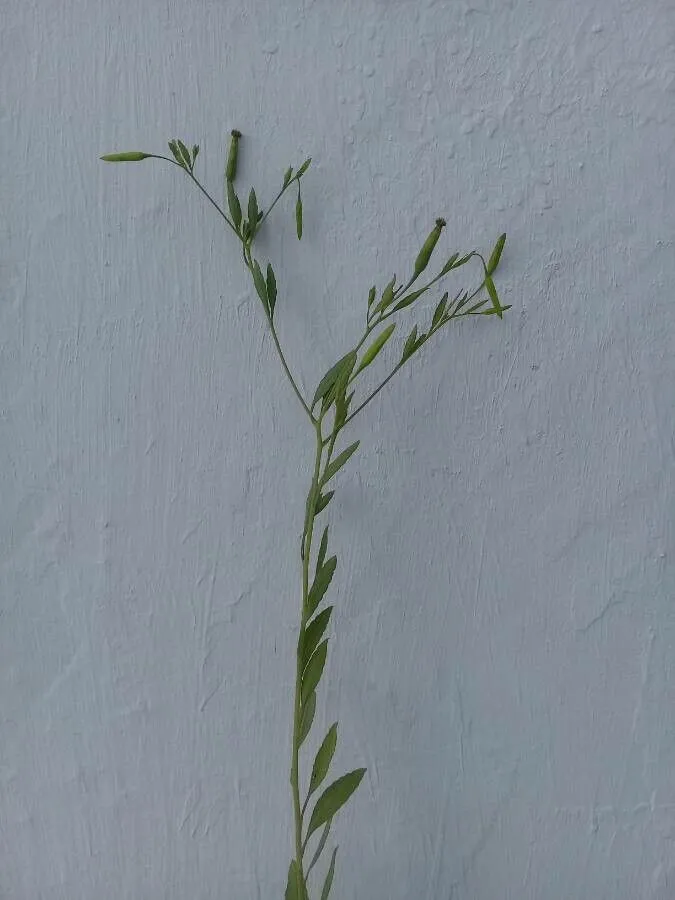
Author: (Jacq.) Cass.
Bibliography: Dict. Sci. Nat., ed. 2, 43: 56 (1826)
Year: 1826
Status: accepted
Rank: species
Genus: Porophyllum
Vegetable: False
Observations: Trop. & Subtrop. America
Yerba porosa, scientifically known as Porophyllum ruderale, is a notable member of the Asteraceae family. First detailed in the second edition of the “Dictionnaire des Sciences Naturelles” in 1826, the plant was described by the author (Jacq.) Cass. Its natural habitat stretches across the tropical and subtropical regions of both North and South America.
This intriguing species has garnered attention due to its unique properties and versatility. As part of the sprawling Asteraceae family, yerba porosa shares lineage with other well-known plants such as daisies, sunflowers, and asters, contributing to its diverse and multifaceted characteristics.
Yerba porosa typically thrives in warm climates, often found flourishing in areas with ample sunlight. The plant’s adaptive nature allows it to grow in a variety of soil types, although it exhibits optimal growth in well-drained, nutrient-rich soils. The foliage of yerba porosa is distinguishable by its vibrant green color, making it a visually appealing addition to many gardens and natural landscapes.
Valued in traditional medicine, yerba porosa has been utilized for its potential health benefits. It is reputed for having antimicrobial and anti-inflammatory properties. Indigenous communities often harness the plant’s leaves and stems for preparing herbal remedies aimed at treating a variety of ailments.
In culinary contexts, yerba porosa’s aromatic leaves are sometimes employed as a flavorful herb, imparting a pungent and slightly citrusy taste to dishes. This makes it a cherished ingredient in certain regional cuisines, adding layers of flavor to traditional recipes.
Overall, yerba porosa, or Porophyllum ruderale, is a plant species that stands out due to its medical potential, culinary versatility, and adaptability to different environmental conditions. Its presence across diverse landscapes in the Americas underscores its resilience and significance both ecologically and culturally.
Eng: yerba porosa
Spa: yerba porosa
En: Yerba porosa
Es: Yerba porosa
© copyright of the Board of Trustees of the Royal Botanic Gardens, Kew.
© copyright of the Board of Trustees of the Royal Botanic Gardens, Kew.
© copyright of the Board of Trustees of the Royal Botanic Gardens, Kew.
Taken Oct 16, 2014 by EOL − Richard Spellenberg (cc-by-nc-sa)
Taken Oct 16, 2014 by EOL − Richard Spellenberg (cc-by-nc-sa)
Taken Mar 29, 2012 by EOL − Zoya Akulova (cc-by-nc)
Taken Jun 16, 2022 by Ebenezer Owusu (cc-by-sa)
Taken Nov 29, 2021 by CLAN PELEGOLAS (cc-by-sa)
Taken Sep 1, 2021 by renato barbosa (cc-by-sa)
Taken Sep 13, 2019 by Bartolomé (cc-by-sa)
Taken Jun 6, 2021 by Fernando da Luz Schmidt (cc-by-sa)
Taken Jun 6, 2021 by Fernando da Luz Schmidt (cc-by-sa)
Taken Oct 30, 2021 by pedrogc — (cc-by-sa)
Taken Apr 1, 2022 by Tom Coyot (cc-by-sa)
Taken Jul 22, 2014 by Tela Botanica − Djah François MALAN (cc-by-sa)
Taken Nov 30, 2014 by EOL − Sam Kieschnick (cc-by-nc)
Taken Jul 22, 2014 by Tela Botanica − Djah François MALAN (cc-by-sa)
Taken Nov 29, 2021 by CLAN PELEGOLAS (cc-by-sa)
Taken May 5, 2021 by paz Jorge (cc-by-sa)
Taken Oct 16, 2014 by EOL − Richard Spellenberg (cc-by-nc-sa)
Taken Mar 29, 2012 by EOL − Zoya Akulova (cc-by-nc)
Taken Feb 27, 2021 by nunes Nazaré (cc-by-sa)
Taken Oct 30, 2021 by pedrogc — (cc-by-sa)
Taken Jan 22, 2020 by Vicente Astaruth (cc-by-sa)
Growth habit>: Forb/herb
Family: Myrtaceae Author: (F.Muell.) K.D.Hill & L.A.S.Johnson Bibliography: Telopea 6: 402 (1995) Year: 1995 Status:…
Family: Rubiaceae Author: Pierre ex A.Froehner Bibliography: Notizbl. Bot. Gart. Berlin-Dahlem 1: 237 (1897) Year:…
Family: Sapindaceae Author: Koidz. Bibliography: J. Coll. Sci. Imp. Univ. Tokyo 32(1): 38 (1911) Year:…
Family: Asteraceae Author: A.Gray Bibliography: Pacif. Railr. Rep.: 107 (1857) Year: 1857 Status: accepted Rank:…
Family: Fabaceae Author: Medik. Bibliography: Vorles. Churpfälz. Phys.-Ökon. Ges. 2: 398 (1787) Year: 1787 Status:…
Family: Aspleniaceae Author: (Cav.) Alston Bibliography: Bull. Misc. Inform. Kew 1932: 309 (1932) Year: 1932…